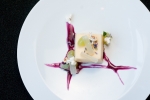Technique: Chartreuse Candy at Custom House Tavern

 Jessica Dukes
Jessica DukesRecipe
Photos
Pastry Chef Bryce Caron of Custom House Tavern in Chicago likes his desserts with a boozy kick, so for three years he toiled to incorporate liquor into his candies. Each attempt failed. Caron based his experiments on a recipe for liquor caviars from the famed Spanish Pastry Chef Paco Torreblanca, but something about the formula just didn’t work.
This fall, Caron finally had his candy denouement. He heated his syrup to 109ºC, several degrees lower than Torreblanca recommends, and the candies didn’t crystallize, leaving their hallmark liquid centers intact. Just in time for Concord grape season—and enchanted by grape and Chartreuse cocktails—Caron found sweet success with Green Chartreuse Candies that he pairs with Popcorn Mousse and Concord Grape Sauce. The delicate candies crack open, and their liquid centers self-sauce the plate, robbing the dessert of its innocence at once. The effect is nothing short of intoxicating.
The candy’s ingredient list is simple: sugar, water, and Green Chartreuse—the herbal liqueur whose recipe of 130 herbs and plants is guarded by monks in the Chartreuse mountains of France. But the technique requires precision and patience. The Chartreuse has to be incorporated into hot syrup without stirring—stirring the liquid causes the syrup to crystallize, and the candies won’t maintain their lush, liquid centers. Instead of swirling the syrup with a spoon, Caron adds a portion of the Chartreuse to the syrup, transfers the mixture to a bowl, and covers it with a damp towel. He repeats the process until all the Chartreuse is incorporated.
He then pours the Chartreuse syrup into handmade cornstarch molds and dehydrates the candies until they form shells. At that point, he uses a makeup brush to gently remove excess cornstarch, and he dips the candies into cocoa butter to strengthen their delicate shells and give them sheen.
Since mastering Chartreuse candy—fine dining’s spiked answer to Gushers—candy man-mixologist Caron has produced Manhattan, Negroni, and Margarita candies. “You can use any liquor you want,” he says. “You just have to be mindful of raising the sugar content.” And following a year where pastry chefs began dabbling in mixology, Caron bridges the gap between bar and plate by serving his booze neat, enclosed in a crunchy candy shell.
Chartreuse Candy:
Step 1: Take a large quantity of cornstarch and dehydrate it overnight in a low oven.
Step 2: Sift the cornstarch, pour it onto trays, and level it off.
Step 3: Prepare candy molds by making desired indentstion in the starch.
Step 4: Bring sugar and water to a boil.
Step 5: Pour a portion of the Chartreuse into the syrup without stirring. Transfer the mixture to a bowl, cover with a wet towel, and rest. Repeat until all the chartreuse is added and the mixture is homogenized.
Step 6: Pour the Chartreuse syrup into a squeeze bottle, and squeeze the liquid into the molds.
Step 7: Cover the candies with additional sifted corn starch.
Step 8: Dehydrate the candies until their shells harden.
Step 9: Brush off the cornstarch.
Step 10: Dip the candies in tempered cocoa butter.








